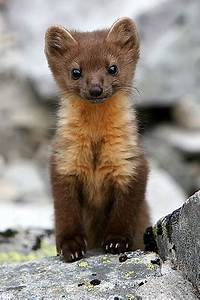First of all, what is a Marten? It's a weasel-like animal that resembles the domesticated ferret, with a longer tail. These fuzzy creatures are certainly adorable-- I was introduced to them while watching a segment of Planet Earth in my Intro to Geography class. The narrator explained that the Pine Marten, only found in taiga climates (for those less seasoned geographers, these are cold forest climates that have cool springs and summers), was hunting for some spring food while it climbed a nearby tree. I expected a screenshot of the Marten cracking open a pinecone and eating some seeds. Instead, it entered a hole in a tree and came out with a dead, limp squirrel. A carnivore? I was very surprised. Although the Marten can survive on plants, it is a hunter, and so prefers to hunt squirrels and small rodents.

The Pine Marten prefers to live in very old forests, because dead trees make great homes for them, and the forest provides plenty of food for the Martens to hunt. They are expert tree climbers, and their sharp teeth make them great hunters. The martens don't hibernate, they are active all year long, and they prefer to live by themselves. They are extremely territorial wild animals. The species is hunted and coveted for its very soft fur, but it is only endangered in some areas. In more rural areas, the Marten thrives in deciduous forests within the taiga climate. This website encourages viewers to donate to the Endangered Resources Fund in Wisconsin to help save the Pine Martens and other endangered species threatened by humans: http://dnr.wi.gov/org/caer/ce/eek/critter/mammal/pinemarten.htm
Logging is also a danger to the Martens since they thrive only in old forests. They need this habitat to continue to thrive as a species. I tried to find a video of the cute Marten taking advantage of an innocent squirrel, but I couldn't find any hunting videos-- the cute pictures above will have to suffice, although they might leave you with a different visual impression than the one that I initially had.
Needless to say, this ferret-like animal definitely deserves the title of unique because of its adaptations to cold climates and its hunting abilities. Not many species can be found in the taiga climate, especially species that roam year-round.

